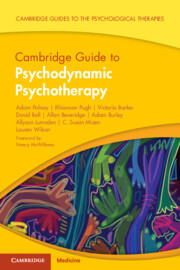Book contents
- Cambridge Guide to Psychodynamic Psychotherapy
- Cambridge Guides to the Psychological Therapies
- Reviews
- Cambridge Guide to Psychodynamic Psychotherapy
- Copyright page
- Dedication
- Contents
- Foreword
- Preface
- A Note from the Series Editor
- Acknowledgements
- Part 1: An Overview of the Model
- Part 2: The Model of Psychodynamic Psychotherapy into Practice
- Part 3: Application for Mental Health Presentations
- Applications of Psychodynamic Psychotherapy with Accompanying Case Study Description for Each Presentation
- Chapter 11 Psychodynamic Approaches to Anxiety
- Chapter 12 The Psychodynamics of Depressing/Depressed States
- Chapter 13 Dynamics of Borderline States of Mind
- Chapter 14 Narcissistic Difficulties, a Trans-Diagnostic Presentation Requiring a System-Wide Approach
- Part 4: Application of Psychodynamic Psychotherapy in Different Populations and in Different Settings
- Glossary of Terms
- Index
- References
Chapter 12 - The Psychodynamics of Depressing/Depressed States
from Applications of Psychodynamic Psychotherapy with Accompanying Case Study Description for Each Presentation
Published online by Cambridge University Press: 25 August 2023
- Cambridge Guide to Psychodynamic Psychotherapy
- Cambridge Guides to the Psychological Therapies
- Reviews
- Cambridge Guide to Psychodynamic Psychotherapy
- Copyright page
- Dedication
- Contents
- Foreword
- Preface
- A Note from the Series Editor
- Acknowledgements
- Part 1: An Overview of the Model
- Part 2: The Model of Psychodynamic Psychotherapy into Practice
- Part 3: Application for Mental Health Presentations
- Applications of Psychodynamic Psychotherapy with Accompanying Case Study Description for Each Presentation
- Chapter 11 Psychodynamic Approaches to Anxiety
- Chapter 12 The Psychodynamics of Depressing/Depressed States
- Chapter 13 Dynamics of Borderline States of Mind
- Chapter 14 Narcissistic Difficulties, a Trans-Diagnostic Presentation Requiring a System-Wide Approach
- Part 4: Application of Psychodynamic Psychotherapy in Different Populations and in Different Settings
- Glossary of Terms
- Index
- References
Summary
There are many ways of becoming depressed. In this chapter we highlight common developmental themes and therapeutic situations amongst people who experience depressing/depressed states. In particular, we expand on two common clinical constellations in some detail: the first a pattern to do with dynamics of loss and abandonment; and the second a tendency to harsh self-criticism, which leads to a devaluing of oneself and others. We use the phrase ‘depressing/depressed’ state to capture the dynamic nature of depression, as opposed to conceptualising depression as a passive state of affairs when someone ‘just is’ depressed. From a psychodynamic view, this is an active and dynamic situation, where an aspect of someone’s internal world is depressing in some way to that person, leaving them feeling depressed. This chapter approaches the external manifestations of depressing/depressed states not as a discrete ‘disorder’, but more as a ‘basic emotional response’ that signals that something is amiss in an individual’s world which requires attending to and addressing.
Keywords
- Type
- Chapter
- Information
- Cambridge Guide to Psychodynamic Psychotherapy , pp. 184 - 199Publisher: Cambridge University PressPrint publication year: 2023



